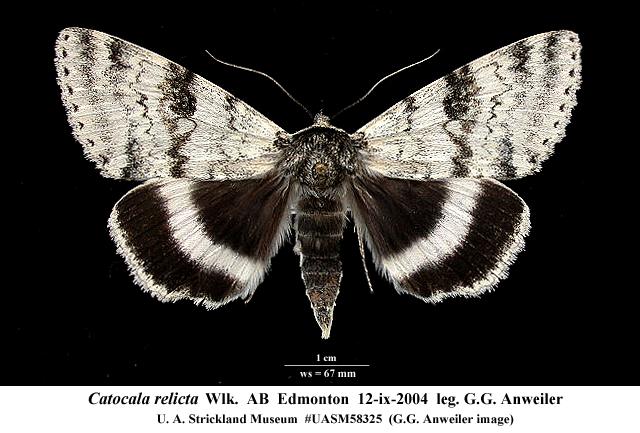Species Details
Catocala relicta
University of Alberta E.H. Strickland Entomological Museum Read more about this collection »
Common NameWhite Underwing, The Relict
SeasonalityAdults are on the wing from late July through September.
IdentificationA large (6.7-7.5 cm wingpan) moth with white forewings crossed by several diffuse black bands and lines, the most prominent being the median band. The hindwings are jet black with a white median band and a narrow white terminal band and fringe. The amount of dark scaling on the forewings varies greatly among populations. The antennae are simple and the adults look alike. Unmistakable.
Scientific Name
Catocala relicta
Common Name
White Underwing, The Relict
Habitat
Mature hardwood and mixedwood forest, in particular aspen forest.
Seasonality
Adults are on the wing from late July through September.
Identification
A large (6.7-7.5 cm wingpan) moth with white forewings crossed by several diffuse black bands and lines, the most prominent being the median band. The hindwings are jet black with a white median band and a narrow…
A large (6.7-7.5 cm wingpan) moth with white forewings crossed by several diffuse black bands and lines, the most prominent being the median band. The hindwings are jet black with a white median band and a narrow white terminal band and fringe. The amount of dark scaling on the forewings varies greatly among populations. The antennae are simple and the adults look alike. Unmistakable.
Life History
Adults are nocturnal and come to light, but they are best collected using sugar baits. The adults emerge in late summer and early fall, and the eggs overwinter. The larvae, which are solitary defoliators, hatch in…
Adults are nocturnal and come to light, but they are best collected using sugar baits. The adults emerge in late summer and early fall, and the eggs overwinter. The larvae, which are solitary defoliators, hatch in May and can be found until early August. There is one brood per year.
Conservation
A common, widespread insect. No concerns.
Diet Info
No Alberta data. Elsewhere in Canada the larvae feed mainly on Aspen poplar (Populus tremuloides). Also reported, much less frequently, from Balsam poplar (Populus balsamifera), willow (Salix) and White birch (Betula…
No Alberta data. Elsewhere in Canada the larvae feed mainly on Aspen poplar (Populus tremuloides). Also reported, much less frequently, from Balsam poplar (Populus balsamifera), willow (Salix) and White birch (Betula papyrifera).
Range
Across southern Canada, from Newfoundland to Vancouver Island, south to Missouri and Arizona. In Alberta, it is found throughout the Aspen parklands, southern Boreal forest north to the northern Peace River area, and…
Across southern Canada, from Newfoundland to Vancouver Island, south to Missouri and Arizona. In Alberta, it is found throughout the Aspen parklands, southern Boreal forest north to the northern Peace River area, and the foothills and lower elevations in the mountains. It is also present in smaller numbers in cottonwood stands along the rivers of the grasslands region (Dinosaur Provincial Park and Lethbridge).
References
Author
Prentice, R. M.
Title
Forest Lepidoptera of Canada. (1962)
Publication Date
1962
Volume
2
Pages
281
Author
Sargent, Theodore, D
Title
Legion of night : the underwing moths
Publication Date
1976
Pages
222
Specimen Information
There are 126 specimens of this Species.
UASM19805 - Catocala relicta
University of Alberta E.H. Strickland Entomological Museum
Place CollectedCanada: Alberta, Edmonton
Collected ByLawrie, D.
Date Collected1997-08-20
UASM19806 - Catocala relicta
University of Alberta E.H. Strickland Entomological Museum
Place CollectedCanada: Alberta, Edmonton
Collected ByLawrie, D.
Date Collected1997-08-06
UASM19807 - Catocala relicta
University of Alberta E.H. Strickland Entomological Museum
Place CollectedCanada: Alberta, Edmonton
Collected ByLawrie, D.
Date Collected1997-08-04
UASM19808 - Catocala relicta
University of Alberta E.H. Strickland Entomological Museum
Place CollectedCanada: Alberta, Edmonton
Collected ByLawrie, D.
Date Collected1997-08-05
UASM19809 - Catocala relicta
University of Alberta E.H. Strickland Entomological Museum
Place CollectedCanada: Alberta, Edmonton
Collected ByLawrie, D.
Date Collected1997-08-02
UASM19810 - Catocala relicta
University of Alberta E.H. Strickland Entomological Museum
Place CollectedCanada: Alberta, Red Deer River
Collected ByLawrie, D.
Date Collected1997-08-30
UASM19811 - Catocala relicta
University of Alberta E.H. Strickland Entomological Museum
Place CollectedCanada: Alberta, Edmonton
Collected ByLawrie, D.
Date Collected1997-08-05
UASM24198 - Catocala relicta
University of Alberta E.H. Strickland Entomological Museum
Place CollectedCanada: Alberta, Buffalo Lake Conservation Area
Collected ByAnweiler, G. G.
Date Collected2002-08-17
UASM58325 - Catocala relicta
University of Alberta E.H. Strickland Entomological Museum
Place CollectedCanada: Alberta, Edmonton
Collected ByAnweiler, G. G.
Date Collected2004-09-12
BIRD5547 - Catocala relicta
University of Alberta E.H. Strickland Entomological Museum
Place CollectedCanada: Alberta, Winfield
Collected ByBird, C. D.
Date Collected2000-09-17
BIRD5548 - Catocala relicta
University of Alberta E.H. Strickland Entomological Museum
Place CollectedCanada: Alberta, Winfield
Collected ByBird, C. D.
Date Collected2000-09-17
BIRD5549 - Catocala relicta
University of Alberta E.H. Strickland Entomological Museum
Place CollectedCanada: Alberta, Buffalo Lake Provincial Recreation Area
Collected ByBird, C. D.
Date Collected2001-08-04
BIRD5550 - Catocala relicta
University of Alberta E.H. Strickland Entomological Museum
Place CollectedCanada: Alberta, Dry Island Buffalo Jump Provincial Park
Collected ByBird, C. D.
Date Collected2001-08-08
BIRD5551 - Catocala relicta
University of Alberta E.H. Strickland Entomological Museum
Place CollectedCanada: Alberta, Erskine
Collected ByBird, C. D.
Date Collected2001-08-12
BIRD5552 - Catocala relicta
University of Alberta E.H. Strickland Entomological Museum
Place CollectedCanada: Alberta, Winfield
Collected ByBird, C. D.
Date Collected2001-08-14
BIRD5553 - Catocala relicta
University of Alberta E.H. Strickland Entomological Museum
Place CollectedCanada: Alberta, Winfield
Collected ByBird, C. D.
Date Collected2001-08-14
BIRD5554 - Catocala relicta
University of Alberta E.H. Strickland Entomological Museum
Place CollectedCanada: Alberta, Rochon Sands Provincial Park
Collected ByBird, C. D.
Date Collected2001-08-23
BIRD5555 - Catocala relicta
University of Alberta E.H. Strickland Entomological Museum
Place CollectedCanada: Alberta, Rochon Sands Provincial Park
Collected ByBird, C. D.
Date Collected2001-08-23
BIRD5556 - Catocala relicta
University of Alberta E.H. Strickland Entomological Museum
Place CollectedCanada: Alberta, Rochon Sands Provincial Park
Collected ByBird, C. D.
Date Collected2001-08-23
BIRD5557 - Catocala relicta
University of Alberta E.H. Strickland Entomological Museum
Place CollectedCanada: Alberta, Winfield
Collected ByBird, C. D.
Date Collected2001-09-02
BIRD5558 - Catocala relicta
University of Alberta E.H. Strickland Entomological Museum
Place CollectedCanada: Alberta, Nevis
Collected ByBird, C. D.
Date Collected2002-08-06
